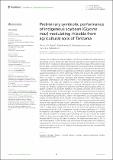Climate-smart aquaculture in Tanzania: Assessment of transitional and heavy metals concentrations in a commonly used local feed ingredient for Tilapia farming

View/
Date
2023-11Author
Vulla, Kelvin
Mmanda, Francis
Makule, Edna
Metadata
Show full item recordAbstract
A study conducted from January through May 2023 to assess the concentrations of heavy and transitional metals in a
commonly used local feed ingredient in a farmed Nile tilapia diet (Oreochromis niloticus) in Tanzania. Eleven fish
feed ingredients such as, sunflower seed cake (SFSC), wheat pollard (WP), maize bran (MB), fish meal (FM),
freshwater shrimp (FWS), cattle blood meal (CBM), bone meal (BM), soya bean meal (SBM), and rice bran (RB),
brewers’ spent grain (BSG) and Taro leaves (Colocasia esculenta; TL) were randomly sampled from feed
manufacturers, animal feeds’ centers and other animal feeds suppliers in Arusha and Dar es Salaam region for
inclusion in this study. Heavy metals and transition metals in feed ingredients were analyzed using the Energy-
Dispersive X-rays Fluorescence (XRF) (Xla Pro-Spectrometer/German) at the Tanzania Atomic Energy Commission
(TAEC) laboratory. The results showed that most of the fish-feed ingredients used in this study comply with the
maximum allowable concentrations in Nile tilapia diets-according to the Tanzania bureau of standards and the
European commission. However, the results showed that, the concentrations of reported metals (As, Pb, Cd, Hg, Co,
Cu, Mo, Mn, Ni, Ag, V, Cr, Fe and Zn) varied significantly (p < 0.05 ) in most of the analyzed local feed ingredients
collected in Tanzania. The study has paved the way for other researchers to further assess more feed ingredients used
not only on heavy metals but other potential contaminants in feeds to ensure sustainable fish farming in Tanzania.
